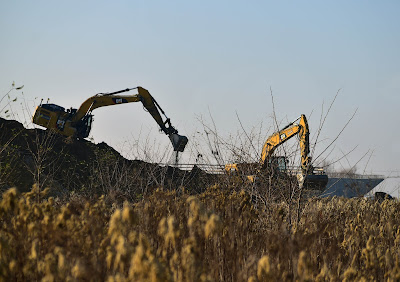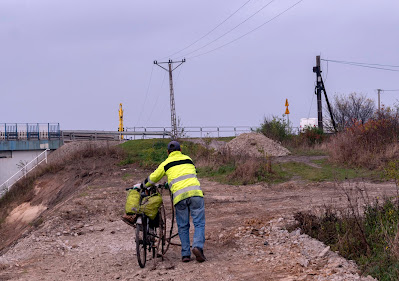The camera in your mobile phone is OK, but taking a photo takes time - you can't just press the shutter and instantaneously capture the moment. Nor can you change lenses for a long telephoto or ultra-wide angle. I have been in the habit of having a camera around my neck for the past 40 years, in the film era, with a succession of Leica rangefinders mainly, and since 2007, digital Nikons.
The most recent - bought two years ago, is a D3500. The newest 'entry-level' Nikon digital single-lens reflex (DSLR) does everything I need, has a high pixel count (24.2 million of them), and above all is so light I don't notice it when out walking for a couple of hours. Weight is one of my main considerations along with excellent image quality (especially when light levels are low), long battery life (good for a month's typical use), ability to take my old film-era Nikon lenses (see further down) and good ergonomics give me everything I need in a camera.
I'd like a larger FX-format Nikon for the higher image quality, but even the new mirrorless ones are much bigger and heavier than the D3500 (which is the smaller DX format). Convenience trumps image quality for the time being. Now, the FX-format sensor is 36mm x 24mm; the same size as a 35mm film frame. DX is 24 x 16mm, two-thirds of FX and 35mm film size. For putting photos on my blog, DX is enough.
Then there are are the more expensive, more feature-laden Nikon DX cameras, but I don't feel the need to advance beyond the entry-level (starting with the old D40, then D3200, now D3500). Can you name any features of an upmarket model costing around double (D5600) or even four times (D7500) the price of the D3500, that give value for that money? Many of these features give you the ability to do things in-camera that I tend to do with Photoshop and its .RAW editor. And while the D5600 weighs the same as the D3200, the D7500 weighs a full 50% more.
So here it is - my favourite, my best all-round camera of all time, great value, seen below with standard kit lens. (Nikon's lenses are branded 'Nikkor', by the way.)
 |
| Tip to self: give the filter a clean. |
Lenses are all important. The basic, plastic kit lens that you get with the D3500 (shown above) is not just adequate, it's downright excellent. It has almost instantaneous autofocus, it's light, it's sharp, it zooms from 18mm (27mm in 35mm/FX format), wide enough for landscape and bigger interiors, out to 55mm (82mm in 35mm equivalent), a mild telephoto and portrait focal length. It's not fast (i.e. it doesn't let in too much light at the long end at f5.6), but it makes up for it with excellent vibration reduction (VR in Nikon-speak, otherwise image stabilisation), happily giving sharp shots at a tenth of a second exposure (assuming the subject's not moving).
The second lens I'll take with me (if I can only take two) is the new Nikon 70-300mm telephoto zoom that replaced my old 55-300mm. I lose a bit at the wider end (I have nothing covering the gap between 55mm and 70mm - it's not a big issue in practice), but I gain in weight and size. For zooming in, there's no alternative, such as walking backwards a bit to frame a wide subject or landscape. But to get in close you need a long lens; 300mm is the equivalent of 450mm in 35mm format, which is a big and heavy mother.
The third lens (if I can only take three) is the new Nikon 10-20mm wide-angle zoom that replaced my old 10-24mm. Again, I lose at the longer end (covered anyway by the standard 18-55mm lens), but I gain a much lighter and pocketable lens that also boasts VR, which the older lens didn't have. The 10mm end is very wide, not quite fisheye, but handy in cramped spaces. Photoshop can iron out the fly-away diverging verticals that come with such wide-angle lenses.
These three lenses cover about 95% of daytime photography needs; when darkness falls, wider apertures come in handy. Here, I have 35mm f1.8 and 50mm f1.4 lenses (52mm and 75mm equiv.), plus a real favourite of mine, this old manual-focus, manual-mode exposure 24mm f2 (36mm equiv.) lens (see below). These get taken for twilight walks, but none have vibration reduction, so hand-holding is limited to the reciprocal of the FX-equivalent focal length (from 1/36th for the 24mm to 1/75th for the 50mm). I also have an old 55mm f3.5 micro-Nikkor for the rare close-up.
 |
Looking good with a classic Nikkor 24mm f2 lens!
|
Filters - a basic skylight or UV filter for every lens, acting as a transparent lens-shield, preventing scratching of more expensive optics. Unlike a lens cap, you don't have to take it off before shooting. Just remember to give the filter a wipe every now and then! One 'effect' filter I do use, and only on the standard 18-55mm lens, is the circular polarising filter, which intensifies the blueness of the sky on a cloudless day. This effect works less well on the superwide 10-20mm lens (only partial coverage) and hardly at all on telephoto lenses, so one is enough.
Two other cameras I have; the ultra-compact Nikon Coolpix A, with its fixed focal-length 18mm lens, now my travel companion for motorbike rides (and took all the pictures on this post), and the superzoom Nikon Coolpix P900, used chiefly for snapping birds and planes on sunny days - its long lens being the equivalent of 2000mm on a 35mm film camera. The Coolpix A is a great little camera, sadly discontinued and never replaced, its DX-format sensor and tiny size prove that Nikon could make something in FX that's around one-third bigger and one-third heavier, and yet would still be eminently totable for all-day use around the neck.
But for everyday use - and I mean every day - the Nikon D3500 with its 18-55mm kit lens is the perfect companion. I highly recommend it. Should Nikon ever discontinue its entry-level DX-format DSLR line, I'll buy one to put down for the future. It'll be a classic.
Below: sample of the lens quality. This is the basic kit 18-55mm lens that comes with the body. The photo is taken hand-held at 1/13th second at f4, ISO 1400 (so it's grainy), lens zoomed in to 24mm (36mm equiv). And it's a compressed .JPEG file to accommodate the requirements of uploading to the web. Printed full-size, this image would measure 50cm x 33cm. Try doing this with your phone-cam!
Note the red lines in the bottom left corner. Lenses are generally sharper at the middle of the image than at the edges. Let's crop that fragment and blow it up... This image printed to full size would be around 10cm square, just under the width of a page of A4. [Click to enlarge.]

At this moment, the D3500 with 18-55mm VR lens costs around 1,700 złotys in Poland (around £340), with similar prices in the UK (pound currently at 5zł). That's an absolute bargain.
Consider this: the new, mirrorless DX-format Nikon Z50 boasts fewer megapixels than the D3500 (21MP vs. 24MP); it weighs more (450g vs. 415g body only); its battery life is far shorter; it doesn't take old Nikon film-camera lenses, and despite all that, at 4,100 złotys, it's more than twice the price of the D3500!!!. It makes no sense whatsoever to buy the Z50. None, zero. If you want to move up to FX format, then yes, the larger Z6 and Z7 mirrorless Nikons do compare favourably in terms of weight with their DSLR rivals such as the D780 and D850. But the cost of moving to FX is huge; the cheapest Nikon FX body (the D750) costs two-and-half times as much as the D3500 with kit lens.
 |
Battery charged six times since 27 July; in almost-daily use.
|
I have a number of Nikon lenses that are surplus to requirements. My old 55-300mm zoom, faster, longer zooming range, but more robust and therefore heavier than its 70-300 replacement; a 16-85mm general-purpose zoom that has more useful range than the 18-55mm, but is far heavier; a massive 80-400mm telephoto zoom for FX and DX cameras - this doesn't autofocus with the D3500 body (and has been replaced on supertelephoto duties by the Coolpix P900 anyway); and an old-school manual-focus 28mm f2.8 prime lens. Also for sale are a 55-200mm lens, and a manual-focus 135mm f3.5 prime telephoto lens. Let me know if you are interested.
UPDATE September 2025: My D3500 rules. In November 2021, I bought a D5600 to hang on to for the deep future, using it sparingly; the D3500 is still my principle camera for daily (and I mean daily) use. One battery charge lasts me three weeks plus. Last month I had the sensor cleaned (50 złotys/£10 at BT Foto, Aleja Armii Ludowej 12, service while-you-wait). Over the seven years I've owned the camera, I've taken 46,231 exposures. (To check, I open last the image I took in Photoshop, then go File -> File Info -> Raw Data-> the scroll down the list, in tiny letters, until <aux:ImageNumber> 46231 </aux:ImageNumber>. That's about 18 images a day, every day, since I bought the camera.
This time last year:
Agnieszka Holland's Mr Jones reviewed
This time two years ago:
The Earth is flat
This time three years ago:
50th Anniversary of the Fiat 125p
This time four years ago:
Fidel Castro's death divides the world
This time five years ago:
London to Edinburgh by night bus
This time seven year ago:
The Regent's Canal, London
This time nine years ago:
An end to the entitlement way of thinking
This time ten year:
West Ealing - drab and sad end of town
This time 11 years ago:
To Poznań by train
This time 13 years ago:
Late autumn drive-time








































